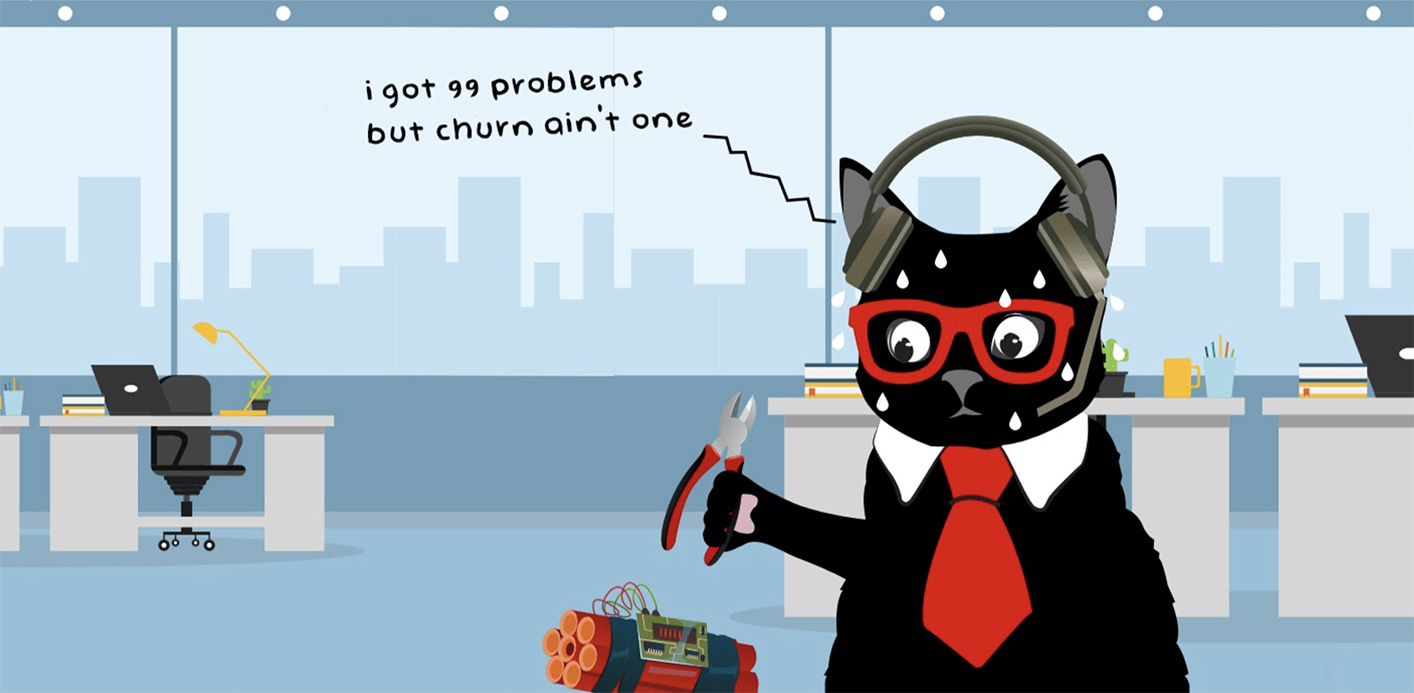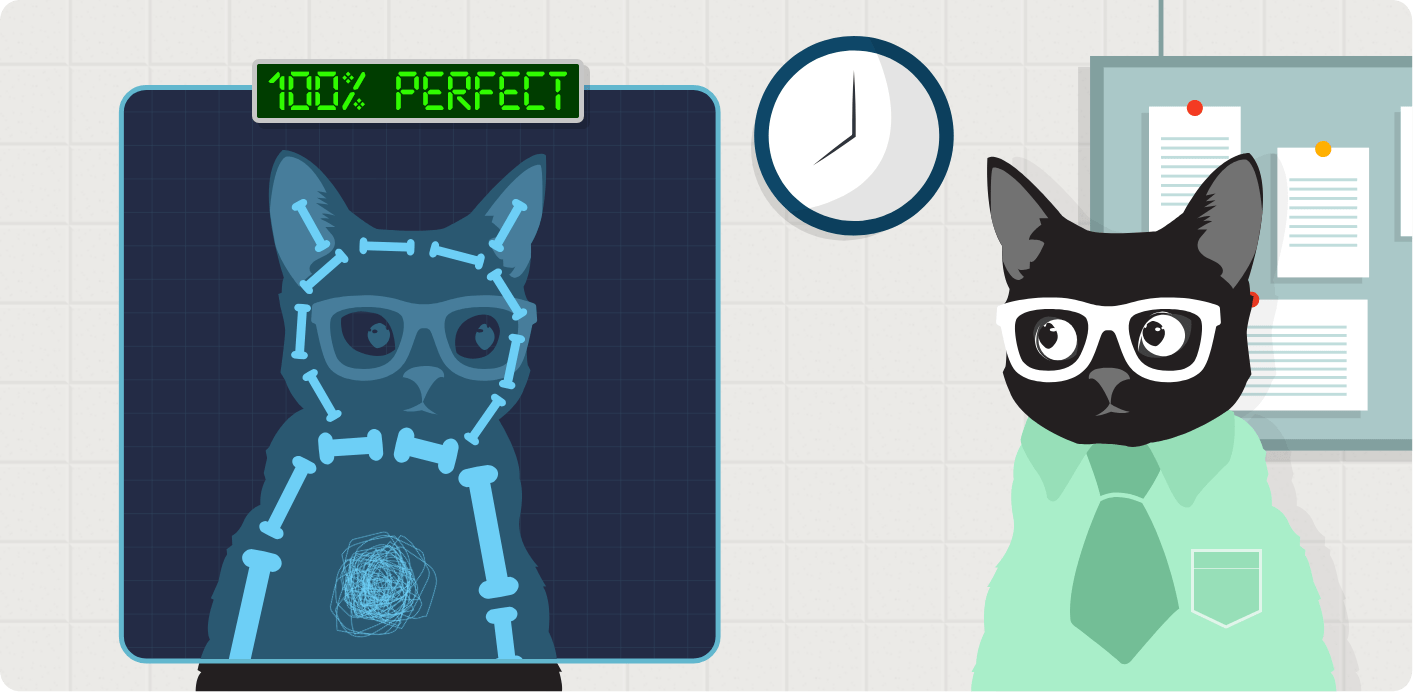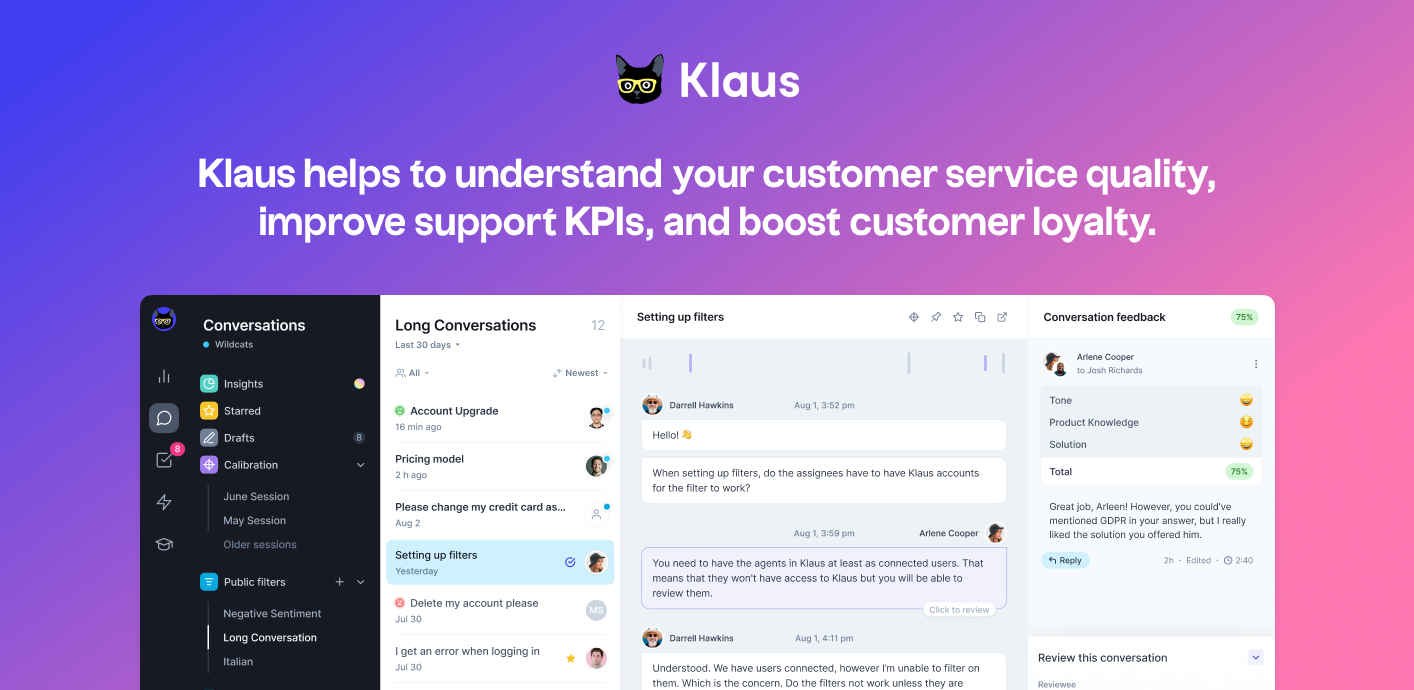There isn’t a single business out there that hasn’t lost customers. Learning how to reduce customer churn is a vital tactic in preserving growth.
Neither fast-growing startups nor decade-old enterprises are immune.
Unfortunately, combating churn is an uphill and ongoing struggle that every business will face as long as they exist.
But with customer retention being five times cheaper than acquiring new customers, it’s a battle well worth fighting.
![]()
What is churn (rate)?
Customer churn or churn rate is the rate at which customers stop doing business with your company. Essentially, it tells you how many customers you’ve lost relative to the new customers you’ve gained in a specific time period.
To calculate customer churn rate, use the following formula:
(Number of customers lost in a given period of time / Number of customers at the beginning of the period) x 100 = Churn rate
For example, if you had 500 customers at the beginning of the quarter and lost 50 customers during that time, the customer churn rate would be 10% = (50 / 500) x 100.

There isn’t a single business out there that hasn’t lost customers. Yet, monitoring and reducing churn rate is important for customer retention and ensuring healthy growth.
You could try and combat customer churn with growth. However, this strategy is like trying to fill a leaky bucket with more water.
Eventually, growth will hit a wall and it just won’t be feasible to acquire more customers.
So rather than worry about churn and all the potential revenue you’ve lost then, it makes sense to retain as many customers as possible right from now.
- Customer churn rate provides insights into how well you are retaining customers, and how satisfied they are. By tracking the percentage of customers leaving your business, you can identify any issues or areas of improvement that might be impacting customer satisfaction.
- Customer churn directly affects your business’s revenue and growth potential. Customer acquisition can be costly, so retaining existing customers is crucial for sustainable growth.
- Customer churn rate is closely tied to customer lifetime value. Customers who stay with your business for a longer duration tend to generate more revenue and contribute to higher CLV. By monitoring churn rate, you can understand the average lifespan of your customers and evaluate the effectiveness of your customer retention strategies.

Understanding what causes customer churn
If you’re going to try and reduce customer churn rate at your business, you first need to identify the potential causes of churn. So below, we’ve outlined the top reasons for customer churn:
- Attracting the wrong audience
- Customers don’t see value fast enough
- Lack of ongoing customer success
- Poor customer support
Does any of those seem familiar? Let’s take a closer look.

You’re attracting the wrong audience
Your products or services are not meant for everybody, and that’s okay. But, sometimes there’s a disconnect between what a customer believes your product can do, and what it can actually do.
This can be a result of:
- a lack of understanding of what your ideal customer looks like,
- issues with your lead qualifying standards, or,
- unclear messaging.
And while attracting such customers can boost numbers in the short term, they’re unlikely to stay for long and will eventually churn.

You’re having onboarding issues
When customers sign up for a SaaS product, they do so to achieve very specific outcomes.
So if they don’t understand how to navigate your tool and achieve these goals quickly, they’ll get dissatisfied and churn.
Simply put, if achieving that first moment of success takes too long, the customer will be gone.
The easiest solution for this is tweaking your onboarding process to more effectively guide customers to achieve their goals more quickly. This gap between sign-up and success is called “Time to Value” or TTV and is a critical metric for SaaS products.

There’s a lack of ongoing customer success
Helping your new customers achieve value is a nice early win for you. But it doesn’t end there. In fact, it only really means that you’ve bought yourself a bit more time.
You’ll need your product to consistently deliver value to your customers and help them achieve mini-goals that drive them closer to their ultimate objective.
Customer retention and loyalty go hand in hand.
So for your most valuable customers, it might be worth having a dedicated customer success team to help them get the most out of your product at every stage of their journey. For others, make it easy for them to provide customer feedback throughout their lifecycle. That way you can respond quickly if they start to show signs of dissatisfaction.

You offer poor customer service
No matter how good your product is, your customers are bound to eventually run into issues.
But if you want to prevent these issues from becoming dealbreakers, you need your support to be accessible, responsive, and effective across all your support channels.
Here are a few things you should do:
- Set clear customer service goals and implement systems to achieve them,
- Provide training that helps your agents perform to the best of their abilities,
- Regularly track your customer service metrics to identify areas of improvement.
Make customer support a priority and you’ll start reaping the benefits, including preventing churn.
Now, this isn’t an exhaustive list by any means, just the most common causes. Other reasons for customer churn could include things like product bugginess, a difficult customer experience, cheaper alternatives, or a loss of key stakeholders, etc.
Knowing the major causes is a good start in understanding how to reduce customer churn. But now you need a way to identify if they’re happening at your organization.
And this is exactly where conversation reviews come in.

How to prevent customer churn with conversation reviews
So you now know the reasons, but let’s get into customer churn detection. Your ability to slow the revolving door that is the inevitability of customer turnover is determined by how well you can predict which customers are considering their departure.
Reviewing your support conversations systematically is the key to understanding customer satisfaction, feedback, and sentiment. And, of course, how well your team and product are meeting up to expectations.

Analyze reasons for customer churn
Uncovering why customers have canceled in the first place is essential to preventing it from happening again in the future.
A good way to go about this is by:
- Retrieving conversations of churned customers by company ID.
- Filtering to find conversations with negative CSAT.
- Filtering to find conversations with negative sentiment.
- Filtering through Spotlight to find complex conversations.
Read through these interactions for a nuanced understanding of their issues. Investigate to see if you could have done anything differently and consider action points for bringing them back aboard at a later date, e.g.: when you open another support channel that they asked for, or when a new product feature is likely to suit their needs.

Identify things you could have done to save the relationship
If multiple users start churning for similar reasons, this is cause for concern. And you’ll need to fix this right away.
The best way to identify these trends is by reviewing support interactions, especially if the reason isn’t something you can immediately detect.
Going through support conversations is also a great way to find parts of your system that are broken. For example, let’s say you review a conversation with a customer that asks to cancel. And support processes the cancellation without further question. You might want to tweak your process to deal with these situations more effectively (ie. asking the customer why they want to cancel first).
Once you identify the causes of customer churn at your business, you’ll need to follow this up with more action. Let’s dive deeper into how you can use these insights with 6 actionable ways to combat customer churn.
How to reduce customer churn
The methods mentioned here aren’t one-time quick fixes you can just implement. Rather, they’re practices you need to make a part of your process and perform consistently to see the results.

Proactively list all the reasons a new customer may churn
One of the best ways to combat customer churn before it becomes a problem is to prepare yourself for it.
Whenever you onboard a new customer of significant value, identify all the possible reasons why they may churn at the different stages of their journey. Follow this up with an action plan that prevents each one of those hypothetical scenarios from taking place.
Mapping out the journey your customers take and anticipating the obstacles they may face along the way allows you to optimize the customer experience and thereby prevent churn.

Talk to your customers regularly
Building better relationships with your customers goes hand in hand with learning how to reduce customer churn.
This is the only way you’ll gain a thorough understanding of their problems, which in turn allows you to prescribe how they can best use your product and get the most out of it.
Many a time, you’ll find that your customers will struggle to articulate what exactly they need or are trying to solve. So you’ll need to do a lot of discovery to understand what they’re trying to accomplish before making any recommendations.
Additionally, if you notice many of your users facing the same problem, you could also update your product to suit their needs before they end up churning.

Be transparent and set clear expectations
You must be honest and transparent with your customers. And this needs to be consistent across your marketing, sales, and support teams.
For example, let’s say you’re beta testing a feature that will become a paid add-on after the beta. You’ll want to make sure that your customers are fully aware that this feature will cost money in the future, rather than surprising them with an invoice at the end.
The onus is completely on you to clearly communicate what your customers should and should not expect from you and your product. And for this, you’ll need all your departments to be in sync.

Make the cancellation process simple
This one might sound counterintuitive.
You obviously want to reduce the number of cancellations. But adopting practices like:
- forcing them to contact support,
- hiding unsubscribe/cancel buttons,
- or not responding to cancellation emails
…will actually do you more harm than good. And this is a complete no-no.
These customers are already looking to cancel. And if you make it more difficult for them to do so, they’re likely to spread the word about your shady business practices, which will eventually ruin the reputation of your business. Not to mention, they’ll likely never return.
Keep the cancellation process straightforward. No dark patterns, no need to contact support, nada.
You are much more likely to see a return of these customers in the future, especially if you have a retention team operating.

Set clear processes for your support team to follow
You want to make sure your customer support and customer success playbooks are always up to date and provide clear direction on how to handle different situations with customers.
This is crucial if you’re going to identify and address the early dissatisfaction signals your customers show, whether that’s:
- decreased usage of your product,
- a negative mention on social media or review sites,
- or a bad interaction with your customer service team.
Clear processes will empower your agents to quickly identify and effectively deal with such situations before it’s too late.

Reach out to customers proactively with support
If you’re going to prevent customer churn, your customer support team will need to go above and beyond.
For example, let’s say a customer has a question about a specific feature. You’ll want to make sure your agents don’t just provide an answer but are also able to see the bigger picture.
And this may mean doing things like:
- asking additional questions to understand what users are trying to achieve,
- proactively looking at their product usage statistics,
- inviting them to discover new features, etc.
Your customer support isn’t just about being there for customers when they reach out to you. Instead, you need to offer proactive customer service, anticipate their needs and start conversations whenever you think it could be helpful.

Empower your agents to combat customer churn
Customer churn can be a silent killer if you allow it to be. But hopefully, we’ve given you a path to identify and tackle it early.
And one of the best bets you can make to prevent customer churn is investing in your customer support team.
That means providing them with feedback and coaching that’ll help them to perform to the best of their abilities.
Originally published in February 2023; last updated in May 2023.




